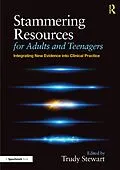This comprehensive and practical resource is a second volume to the highly influential Dysfluency Resource Book (2010). It brings together the very latest developments in the field of stammering and dysfluency in adults and teenagers and builds upon some of the approaches explored in the Dysfluency Resource Book. The book draws on the expert knowledge of contributors from a wide range of fields, such as specialist speech and language therapy, education, psychology and youth work, with a focus on presenting practical guidance for those working in this complex area.
This valuable resource:
. Has chapters exploring the latest clinical developments, such as acceptance and commitment therapy (ACT) and narrative therapy.
. Provides in-depth discussion of some established therapeutic practices, including avoidance-reduction therapy and group work.
. Offers concrete application to theory, both the social and medical models, guiding the reader on how to integrate new evidence into clinical practice.
. Provides a wealth of activities and photocopiable handouts that can be used in practice.
Designed for clinicians and students working with teenagers and adults who stammer, this flexible and practical book embeds an ethos of reflection and adaptation. The detailed overview of therapeutic approaches allows the reader to explore a wide range of techniques, building a strong foundation of knowledge from which to tailor and develop their own practice.
Autorentext
Trudy Stewart is a retired consultant speech and language therapist. She studied in universities in Glasgow, Michigan State (USA) and Leeds. She worked in the UK with children and adults who stammer for nearly 40 years. Her last role was clinical lead of the Stammering Support Centre in Leeds. Trudy has taught undergraduate, graduate and specialist courses for clinicians in the UK, Europe and Sri Lanka, including on the European Clinical Specialisation in Fluency Disorders (ECSF) course. She has carried out research while a clinician, presented her work at international conferences and has written several texts on stammering. Her last book, published in 2016, is Stammering: A Resource Book for Teachers.
Inhalt
Acknowledgements Foreword Introduction Chapter 1: The art and practice of being a clinician working with individuals who stammer. Trudy Stewart & Margaret Leahy Chapter 2: Service delivery. Jonathon Linklater Chapter 3: Stammering and voice. Alison McLaughlin Chapter 4: Narrative practice: Identifying and changing problem stories about stammering. Mary O'Dwyer & Fiona Ryan Chapter 5: Avoidance reduction therapy. Jonathon Linklater Chapter 6: Integrating mindfulness into therapy with people who stammer. Carolyn Cheasman Chapter 7: Integrating acceptance and commitment therapy into stammering therapy. Rachel Everard & Carolyn Cheasman Chapter 8: Working together: the power of the therapeutic group Rachel Everard & Cathinka Guldberg, with Sam Simpson and David Ward Chapter 9: Working with self-help groups. Hilary Liddle & Bob Adams
